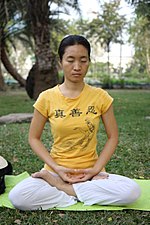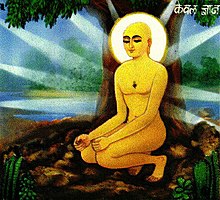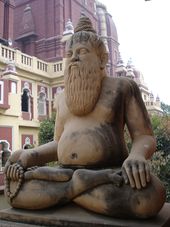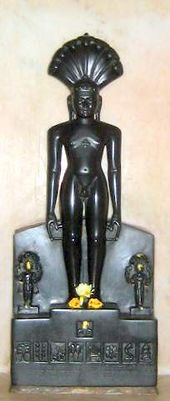Major branches of yoga in Hindu philosophy include Rāja Yoga, Karma Yoga, Jnana Yoga, Bhakti Yoga, and Hatha Yoga.[7][8][9] According to the authoritative Indian philosopher Sarvepalli Radhakrishnan, yoga, based on the Yoga Sutras of Patanjali, comprises one of the six main Hindu schools of philosophy (darshanas), together with Kapila's Samkhya, Gautama's Nyaya, Kanada's Vaisheshika, Jaimini's Purva Mimamsa, and Badarayana's Uttara Mimamsa or Vedanta.[10] Many other Hindu texts discuss aspects of yoga, including the Upanishads, the Bhagavad Gita, the Hatha Yoga Pradipika, the Shiva Samhita and various Tantras.
The Sanskrit word yoga has many meanings,[11] and is derived from the Sanskrit root "yuj," meaning "to control," "to yoke" or "to unite."[12] Translations include "joining," "uniting," "union," "conjunction," and "means."[13][14][15] It is also possible that the word yoga derives from "yujir samadhau," which means "contemplation" or "absorption."[16] This translation fits better with the dualist Raja Yoga because it is through contemplation that discrimination between prakrti (nature) and purusha (pure consciousness) occurs.
Someone who practices yoga or follows the yoga philosophy to a high level of attainment is called a yogi or yogini.[17]
Main article: History of yoga
The Vedic Samhitas contain references to ascetics, while ascetic practices ("tapas") are referenced in the Brāhmaṇas (900 to 500 BCE), early commentaries on the Vedas.[18] Several seals discovered at Indus Valley Civilization (c. 3300–1700 BCE) sites in Pakistan depict figures in positions resembling a common yoga or meditation pose, showing "a form of ritual discipline, suggesting a precursor of yoga," according to archaeologist Gregory Possehl.[19] Some type of connection between the Indus Valley seals and later yoga and meditation practices is speculated upon by many scholars, though there is no conclusive evidence.[20]Techniques for experiencing higher states of consciousness in meditation were developed by the shramanic traditions and in the Upanishadic tradition.[21]
While there is no clear evidence for meditation in pre-Buddhist early Brahminic texts, Wynne argues that formless meditation originated in the Brahminic tradition, based on strong parallels between Upanishadic cosmological statements and the meditative goals of the two teachers of the Buddha as recorded in the early Buddhist texts.[22] He mentions less likely possibilities as well.[23] Having argued that the cosmological statements in the Upanishads also reflect a contemplative tradition, he argues that the Nasadiya Sukta contains evidence for a contemplative tradition, even as early as the late Rg Vedic period.[22]
The Buddhist texts are probably the earliest texts describing meditation techniques.[24] They describe meditative practices and states that existed before the Buddha, as well as those first developed within Buddhism.[25] In Hindu literature, the term "yoga" first occurs in the Katha Upanishad, where it refers to control of the senses and the cessation of mental activity leading to a supreme state.[26] Important textual sources for the evolving concept of Yoga are the middle Upanishads, (ca. 400 BCE), the Mahabharata including the Bhagavad Gita (ca. 200 BCE), and the Yoga Sutras of Patanjali (150 BCE).
Yoga Sutras of Patanjali
Main articles: Raja Yoga and Yoga Sutras of Patanjali
| Pada (Chapter) | English meaning | Sutras |
| Samadhi Pada | On being absorbed in spirit | |
| Sadhana Pada | On being immersed in spirit | |
| Vibhuti Pada | On supernatural abilities and gifts | |
| Kaivalya Pada | On absolute freedom | |
In Hindu philosophy, Yoga is the name of one of the six orthodox philosophical schools.[28][29] The Yoga philosophical system is closely allied with the Samkhya school.[30] The Yoga school as expounded by the sage Patanjali accepts the Samkhya psychology and metaphysics, but is more theistic than the Samkhya, as evidenced by the addition of a divine entity to the Samkhya's twenty-five elements of reality.[31][32] The parallels between Yoga and Samkhya were so close that Max Müller says that "the two philosophies were in popular parlance distinguished from each other as Samkhya with and Samkhya without a Lord...."[33] The intimate relationship between Samkhya and Yoga is explained by Heinrich Zimmer:
These two are regarded in India as twins, the two aspects of a single discipline. Sāṅkhya provides a basic theoretical exposition of human nature, enumerating and defining its elements, analyzing their manner of co-operation in a state of bondage ("bandha"), and describing their state of disentanglement or separation in release ("mokṣa"), while Yoga treats specifically of the dynamics of the process for the disentanglement, and outlines practical techniques for the gaining of release, or "isolation-integration" ("kaivalya").[34]Patanjali is widely regarded as the founder of the formal Yoga philosophy.[35] Patanjali's yoga is known as Raja yoga, which is a system for control of the mind.[36] Patanjali defines the word "yoga" in his second sutra, which is the definitional sutra for his entire work:
योग: चित्त-वृत्ति निरोध:This terse definition hinges on the meaning of three Sanskrit terms. I. K. Taimni translates it as "Yoga is the inhibition (nirodhaḥ) of the modifications (vṛtti) of the mind (citta)".[37] The use of the word nirodhaḥ in the opening definition of yoga is an example of the important role that Buddhist technical terminology and concepts play in the Yoga Sutra; this role suggests that Patanjali was aware of Buddhist ideas and wove them into his system.[38] Swami Vivekananda translates the sutra as "Yoga is restraining the mind-stuff (Citta) from taking various forms (Vrittis)."[39]
(yogaś citta-vṛtti-nirodhaḥ)
- Yoga Sutras 1.2
Patanjali's writing also became the basis for a system referred to as "Ashtanga Yoga" ("Eight-Limbed Yoga"). This eight-limbed concept derived from the 29th Sutra of the 2nd book, and is a core characteristic of practically every Raja yoga variation taught today. The Eight Limbs are:
- Yama (The five "abstentions"): non-violence, non-lying, non-covetousness, non-sensuality, and non-possessiveness.
- Niyama (The five "observances"): purity, contentment, austerity, study, and surrender to god.
- Asana: Literally means "seat", and in Patanjali's Sutras refers to the seated position used for meditation.
- Pranayama ("Suspending Breath"): Prāna, breath, "āyāma", to restrain or stop. Also interpreted as control of the life force.
- Pratyahara ("Abstraction"): Withdrawal of the sense organs from external objects.
- Dharana ("Concentration"): Fixing the attention on a single object.
- Dhyana ("Meditation"): Intense contemplation of the nature of the object of meditation.
- Samādhi ("Liberation"): merging consciousness with the object of meditation.
[edit] Yoga and Samkhya
Main article: Samkhya
Patanjali systematized the conceptions of Yoga and set them forth on the background of the metaphysics of Samkhya, which he assumed with slight variations. In the early works, the Yoga principles appear along with the Samkhya ideas. Vyasa's commentary on the Yoga Sutras, also called the “Samkhyapravacanabhasya,” brings out the intimate relation between the two systems.[41]Yoga agrees with the essential metaphysics of Samkhya, but differs from it in that while Samkhya holds that knowledge is the means of liberation, Yoga is a system of active striving, mental discipline, and dutiful action. Yoga also introduces the conception of God. Sometimes Patanjali's system is referred to as “Seshvara Samkhya” in contradistinction to Kapila's "Nirivara Samkhya." [42]
[edit] Bhagavad Gita
Main article: Bhagavad Gita
The Bhagavad Gita ('Song of the Lord'), uses the term "yoga" extensively in a variety of ways. In addition to an entire chapter (ch. 6) dedicated to traditional yoga practice, including meditation,[43] it introduces three prominent types of yoga:[44]- Karma yoga: The yoga of action,
- Bhakti yoga: The yoga of devotion,
- Jnana yoga: The yoga of knowledge.
योगस्थ: कुरु कर्माणि सङ्गं त्यक्त्वा धनंजय ।A. C. Bhaktivedanta Swami Prabhupada translates it as "Be steadfast in yoga (yoga-sthaḥ), O Arjuna. Perform your duty (kuru karmani) and abandon all attachment (sangam) to success or failure (siddhy-asiddhyoḥ). Such evenness of mind (samatvam) is called yoga." [45]
सिद्ध्यसिद्ध्यो: समो भूत्वा समत्वं योग उच्यते ।।
(yoga-sthaḥ kuru karmani sangam tyaktvā dhananjaya
siddhy-asiddhyoḥ samo bhutvā samatvam yoga ucyate)
- Bhagavad Gita 2.48
Madhusudana Sarasvati (b. circa 1490) divided the Gita into three sections, with the first six chapters dealing with Karma yoga, the middle six with Bhakti yoga, and the last six with Jnana (knowledge).[46] Other commentators ascribe a different 'yoga' to each chapter, delineating eighteen different yogas.[47]
[edit] Hatha Yoga
Main articles: Hatha yoga and Hatha Yoga Pradipika
Hatha Yoga is a particular system of Yoga described by Yogi Swatmarama, compiler of the Hatha Yoga Pradipika in 15th century India. Hatha Yoga differs substantially from the Raja Yoga of Patanjali in that it focuses on "shatkarma," the purification of the physical body as leading to the purification of the mind ("ha"), and "prana," or vital energy (tha).[48][49] Compared to the seated asana, or sitting meditation posture, of Patanjali's Raja yoga,[50] it marks the development of asanas (plural) into the full body 'postures' now in popular usage [51] and, along with its many modern variations, is the style that many people associate with the word "Yoga" today.[52][edit] Modern, Westernised Yoga
In the West, the term "yoga" is typically associated with Hatha Yoga and its asanas (postures) or as a form of exercise.[53] According to Meera Nanda, modern Hatha yoga includes many Western style gymnastics and bodybuilding exercises which were adopted in India in the 19th and 20th centuries[54], but her claims of the extent of these influences have been disputed[55].[edit] Yoga practices in other traditions
[edit] Buddhism
Main article: Buddhism and Hinduism#Meditation
Early Buddhism incorporated meditative absorption states.[56] The most ancient sustained expression of yogic ideas is found in the early sermons of the Buddha.[57] One key innovative teaching of the Buddha was that meditative absorption must be combined with liberating cognition.[58] The difference between the Buddha's teaching and the yoga presented in early Brahminic texts is striking. Meditative states alone are not an end, for according to the Buddha, even the highest meditative state is not liberating. Instead of attaining a complete cessation of thought, some sort of mental activity must take place: a liberating cognition, based on the practice of mindful awareness.[59]The Buddha also departed from earlier yogic thought in discarding the early Brahminic notion of liberation at death.[60] Liberation for the Brahminic yogin was thought to be the realization at death of a nondual meditative state anticipated in life. In fact, old Brahminic metaphors for the liberation at death of the yogic adept ("becoming cool," "going out") were given a new meaning by the Buddha; their point of reference became the sage who is liberated in life.[61]
See also: Pranayama#Buddhism
[edit] Yogacara Buddhism
Yogacara (Sanskrit: "yoga practice"[62]), also spelled yogāchāra, is a school of philosophy and psychology that developed in India during the 4th to 5th centuries. Yogacara received the name as it provided a "yoga," a framework for engaging in the practices that lead to the path of the bodhisattva.[63] The Yogacara sect teaches "yoga" as a way to reach enlightenment.[64][edit] Ch'an (Seon/Zen) Buddhism

A Falun Gong practitioner depicted in yogic meditation in the Lotus position
[edit] Indo-Tibetan Buddhism
Yoga is central to Tibetan Buddhism. In the Nyingma tradition, the path of meditation practice is divided into nine yanas, or vehicles, which are said to be increasingly profound.[69] The last six are described as "yoga yanas": "Kriya yoga," "Upa yoga," "Yoga yana," "Mahā yoga," "Anu yoga" and the ultimate practice, "Ati yoga." [70] The Sarma traditions also include Kriya, Upa (called "Charya"), and Yoga, with the Anuttara yoga class substituting for Mahayoga and Atiyoga.[71]Other tantra yoga practices include a system of 108 bodily postures practiced with breath and heart rhythm. The Nyingma tradition also practices Yantra yoga (Tib. "Trul khor"), a discipline that includes breath work (or pranayama), meditative contemplation and precise dynamic movements to centre the practitioner.[72] The body postures of Tibetan ancient yogis are depicted on the walls of the Dalai Lama's summer temple of Lukhang. A semi-popular account of Tibetan Yoga by Chang (1993) refers to caṇḍalī (Tib. "tummo"), the generation of heat in one's own body, as being "the very foundation of the whole of Tibetan Yoga." [73] Chang also claims that Tibetan Yoga involves reconciliation of apparent polarities, such as prana and mind, relating this to theoretical implications of tantrism.
[edit] Jainism

Kevala Jñāna of Mahavira in "mulabandhasana" posture
Dr. Heinrich Zimmer contended that the yoga system had pre-Aryan origins that did not accept the authority of the Vedas, and hence had to be reckoned as one of the heterodox doctrines similar to Jainism.[77] Jain iconography depicts Jain Tirthankara's meditation in "Padmasana" or "Kayotsarga" yogic poses. Mahavira was said to have achieved "Kevala Jnana" "enlightenment" siting in "mulabandhasana" ('root-lock') position, which is first mentioned in the Acaranga Sutra and later in Kalpasutra [78]
The five yamas or the constraints of the Yoga Sutras of Patanjali bear an uncanny resemblance to the five major vows of Jainism, indicating a strong influence of Jainism.[79][80] This mutual influence between the Yoga philosophy and Jainism is admitted by the author Vivian Worthington who writes: "Yoga fully acknowledges its debt to Jainism, and Jainism reciprocates by making the practice of yoga part and parcel of life." [81] The Indus valley seals and iconography also provide a reasonable evidence of the existence of a proto-yogic tradition akin to Jainism.[82]
More specifically, scholars and archaeologists have remarked on close similarities in the yogic and meditative postures depicted in the seals with those of various Tirthankaras: the "kayotsarga" posture of Rsabha and the "mulabandhasana" of Mahavira along with seals depicting meditative figure flanked by upright serpents bearing similarities to iconography of Parsva. All these are indicative of not only links between Indus Valley Civilisation and Jainism, but also show the contribution of Jainism to various yogic practices.[83]
[edit] References in Jain canons and literature
Earliest of Jain canonical literature like Acarangasutra and texts like Niyamasara, Tattvarthasutra etc. had many references on yoga as a way of life for laymen and ascetics. The later texts that further elaborated on the Jain concept of yoga are as follows:- Pujyapada (5th century CE)
- Ishtopadesh
- Acarya Haribhadra Suri(8th century CE)
- Yogabindu
- Yogadristisamuccaya
- Yogasataka
- Yogavimisika
- Acarya Joindu (8th century CE)
- Yogasara
- Acarya Hemacandra (11th century CE)
- Yogasastra
- Acarya Amitagati (11th century CE)
- Yogasaraprabhrta
[edit] Views of Abrahamic religions
[edit] Christianity
Main articles: A Christian reflection on the New Age and Aspects of Christian meditation
Some Christians attempt to integrate yoga and other aspects of Eastern spirituality with Christian prayer. This has been attributed to a desire to experience God in a more intense way.[84] The Roman Catholic Church, and some other Christian organizations have expressed concerns and disapproval with respect to some eastern and New Age practices that include yoga and meditation.[85][86][87]In 1989 and 2003, the Vatican issued two documents: Aspects of Christian meditation and "A Christian reflection on the New Age," that were mostly critical of eastern and New Age practices. The 2003 document was published as a 90 page handbook detailing the Vatican's position.[88] The Vatican warned that concentration on the physical aspects of meditation "can degenerate into a cult of the body" and that equating bodily states with mysticism "could also lead to psychic disturbance and, at times, to moral deviations." Such concerns can be traced to the early days of Christianity, when the church opposed the gnostics' belief that salvation came not through faith but through a mystical inner knowledge.[84]
The letter also says, "one can see if and how [prayer] might be enriched by meditation methods developed in other religions and cultures"[89] but maintains the idea that "there must be some fit between the nature of [other approaches to] prayer and Christian beliefs about ultimate reality."[84]
Some fundamentalist Christian organizations consider yoga practice to be incoherent to their religious background and therefore a non-Christian religious practice. It is also considered a part of the New Age movement and therefore inconsistent with Christianity.[90]
[edit] Islam
The development of Sufism was considerably influenced by Indian yogic practises, where they adapted both physical postures (asanas) and breath control (pranayama).[91] The ancient Indian yogic text Amritakunda ("Pool of Nectar)" was translated into Arabic and Persian as early as the 11th century. Several other yogic texts were appropriated by Sufi tradition, but typically the texts juxtapose yoga materials alongside Sufi practices without any real attempt at integration or synthesis. Yoga became known to Indian Sufis gradually over time, but engagement with yoga is not found at the historical beginnings of the tradition.[92]Malaysia's top Islamic body in 2008 passed a fatwa, which is legally non-binding, against Muslims practicing yoga, saying it had elements of "Hindu spiritual teachings" and that its practice was blasphemy and is therefore haraam. Muslim yoga teachers in Malaysia criticized the decision as "insulting."[93] Sisters in Islam, a women's rights group in Malaysia, also expressed disappointment and said that its members would continue with their yoga classes.[94]
The fatwa states that yoga practiced only as physical exercise is permissible, but prohibits the chanting of religious mantras,[95] and states that teachings such as the uniting of a human with God is not consistent with Islamic philosophy.[96] In a similar vein, the Council of Ulemas, an Islamic body in Indonesia, passed a fatwa banning yoga on the grounds that it contains "Hindu elements"[97] These fatwas have, in turn, been criticized by Darul Uloom Deoband, a Deobandi Islamic seminary in India.[98]
In May 2009, Turkey's head of the Directorate of Religious Affairs, Ali Bardakoğlu, discounted personal development techniques such as yoga as commercial ventures that could lead to extremism. His comments were made in the context of yoga possibly competing with and eroding participation in Islamic practice.[99]
The only sect of the Islam community that has successfully incorporated yoga into its practice is the Jogi Faqir, whose followers are Muslim converts from the Hindu Jogicaste.
[edit] Tantra
Main article: Tantra
Tantrism is a practice that is supposed to alter the relation of its practitioners to the ordinary social, religious, and logical reality in which they live. Through Tantric practice, an individual perceives reality as maya, illusion, and the individual achieves liberation from it.[100] Both Tantra & Yoga offer paths that relieve a person from depending on the world. Where Yoga relies on progressive restriction of inputs from outside; Tantra relies on transmutation of all external inputs so that one is no longer dependent on them, but can take them or leave them at will. They both make a person independent.[101] This particular path to salvation among the several offered by Hinduism, links Tantrism to those practices of Indian religions, such as yoga, meditation, and social renunciation, which are based on temporary or permanent withdrawal from social relationships and modes.[100]As Robert Svoboda attempts to summarize the three major paths of the Vedic knowledge, he exclaims:
During tantric practices and studies, the student is instructed further in meditation technique, particularly chakra meditation. This is often in a limited form in comparison with the way this kind of meditation is known and used by Tantric practitioners and yogis elsewhere, but is more elaborate than the initiate's previous meditation. It is considered to be a kind of Kundalini Yoga for the purpose of moving the Goddess into the chakra located in the "heart", for meditation and worship.[102]Because every embodied individual is composed of a body, a mind and a spirit, the ancient Rishis of India who developed the Science of Life organized their wisdom into three bodies of knowledge: Ayurveda, which deals mainly with the physical body; Yoga, which deals mainly with spirit; and Tantra, which is mainly concerned with the mind. The philosophy of all three is identical; their manifestations differ because of their differing emphases. Ayurveda is most concerned with the physical basis of life, concentrating on its harmony of mind and spirit. Yoga controls body and mind to enable them to harmonize with spirit, and Tantra seeks to use the mind to balance the demands of body and spirit.[101]


